
Kuro no Kiseki ushers in a new dawn for the Trails series
Vague spoilers for Kuro no Kiseki, be warned!
One of Trails’ greatest strengths is how Falcom is able to reinvent the wheel every time a new “arc” in the series’ overarching story begins. What was once the story of a quaint, remote country on the Zemurian continent could become the tale of a state and its people stuck at the whims of two greater powers, much to the chagrin of its populace and their own desires. Or the story of a war-torn nation; an imperial power coming to grips with its own internal strife – and the bloody history that fueled it. In the end, I didn’t like Trails of Cold Steel as much as its predecessors; I thought many of its changes to the series’ formula were a mistake, and, for all the genuine good that it did for the franchise as a whole, that it did more harm than good. Hajimari no Kiseki (or, as western players will know it – Trails into Reverie) helped temper my impressions of the arc as a whole, but what really stuck with me were the hints of things to come – the Republic of Calvard. A new start, a new theme, and a chance for the series to once again re-invent itself.
I had hoped that Kuro no Kiseki could be a great start to a new arc of the series, but I never expected to walk away, having found what may well be my new favorite game in the series.
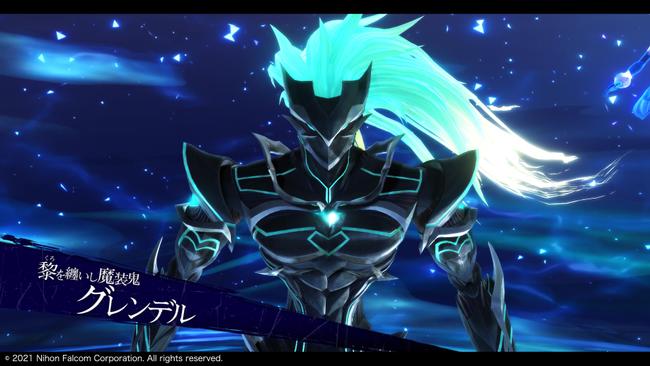
There’s a lot of Kuro that I hesitate to write about. I don’t want to spoil the plot, even if the game wasn’t looking to be several years out from localization – but much like with my Cold Steel IV review, so much of what influenced my enjoyment of the game draws from my own experiences with the franchise as a whole. Kuro draws from more-or-less every other game in the series, including a healthy dose of Hajimari – narrative beats, references to past entries, it’s all here, and not just as simple retreads either. Players can absolutely start with Kuro if they’ve never touched the series before now, but on the other hand, I’d find it incredibly hard to recommend to skip any games just to play Kuro. Unlike previous entries where it felt like the game relied too heavily on its history to anchor an otherwise underwhelming plot, Kuro’s narrative absolutely stands on its own, while players that have been with the series since the beginning will still benefit from little nods and callbacks that others might miss.
I can’t exactly write about the how and why that works without spoilers, however, so one thing I will make a note of is Kuro’s tone. If you’ve been following Falcom’s own marketing on the lead-up to the game’s release, you’ll know that the company made a big deal about how Kuro would be a much darker, more serious entry in the series; I’m more than pleased to confirm that did, indeed, turn out to be the case. I’ll be blunt – people die in Kuro. More than I would’ve expected heading in. I won’t go into the details, but it’s not like these deaths are just meaningless affairs. They’re a meaningful part of the plot, and the way that the game’s characters grow and evolve.
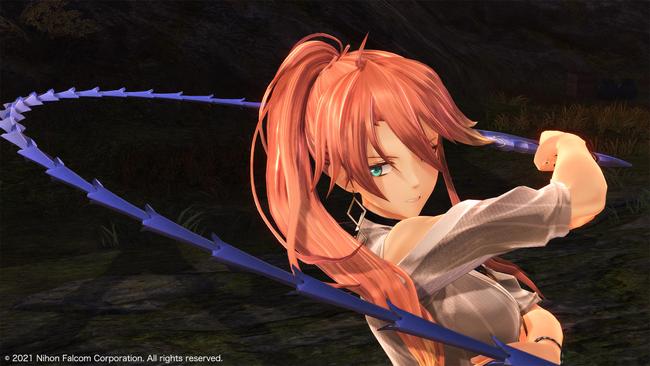
Speaking of characters – it’s tough to talk about Kuro’s main cast, and to try and compare them to other parties from the series' history. It’s not exactly fair when their stories simply aren’t finished yet, there’s obviously still room for them to grow. Some characters in Kuro, like Aaron, see a lot of development in their first outing; others, like Judith, are clearly being saved for later down the line. This isn’t a bad thing, because the party’s chemistry is fantastic, and Kuro’s story is more about Van and his character than anything else.
I’ll say it right now: Van Arkride is my favorite main character in the entire series already. Having a Trails story told through the perspective of an older, more seasoned character does wonders for Kuro as a whole – he’s not just a starry-eyed kid. He’s willing to bend the rules and get his hands dirty if he thinks it’s necessary. As he’s quick to explain, it’s not that his morals are black, or white, or even gray – he aims to help others with his own unique sense of justice. As cheesy as it sounds, it works, and seeing his blunt, sometimes sarcastic reactions to the plot is a breath of fresh air. Having him act as something akin to a mentor for the rest of the cast makes the moments when they return the favor feel all the more genuine and real.
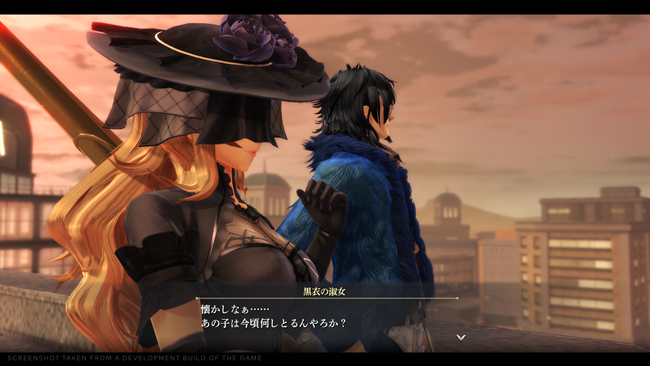
Sidequests are another one of the game’s strong points. Look deep into your heart, and you’ll know it to be true – even though the games have always said that we’re playing as different factions, different groups of people, we’ve always been doing the same sort of sidequests that Bracers did all the way back in Trails in the Sky. For the first time in the series’ history, that’s no longer the case with Kuro and Spriggan Solutions. When Falcom said that they wanted to design sidequests that simply couldn’t be resolved by Bracers or the Police, they managed to deliver by far the most interesting assortment of sidequests in the series’ history.
For some examples; an NPC’s friend stole money from the register at his job, but the NPC doesn’t want to report him to the Bracers or the Police because he’s more worried about why he did the deed than the deed itself. In another quest, a concerned parent is worried about the recent actions of her child, whom she has high hopes of getting accepted into a prestigious academy; eventually we learn that the child’s desire for meeting his parents’ expectations had him searching for drugs to help maintain his concentration while studying. Or what about the request from a client to find his “long lost sister”, when it eventually turns out that the reason it was so hard to locate her, was because the client in question was a simple stalker and she’s been deliberately hiding from him?
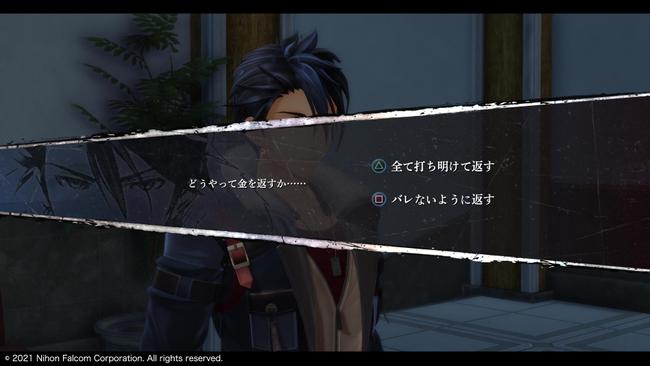
Sidequests are interesting enough, but the glue that helps it all stick would have to be the new LGC (Law, Gray, Chaos) alignment system – at certain points during both the main story and during sidequests, you’ll be tasked to choose how to proceed with a situation. Is it still possible for a family to repair themselves for the sake of their son, or would it be best for everyone involved if you recommended a divorce? Now that you know that the client came to you under false pretenses, what’s the best way to proceed; is it ok to simply leave things in the law’s hands, or would greasing the wheel to prevent a stalker from harming anyone else be worth bending the rules? As you continue through the game, each of your levels for each alignment will grow according to the choices you make during these key moments. Most of the time these changes will have little bearing on the overall plot, but I think I’m alright with that – it still adds just a little bit of extra nuance to sidequests, which is more than worth it at the end of the day. I’d also rather keep any potential alternate events for a series as long-running as Trails to a minimum, frankly.
I wasn’t sure what to make of the new battle system from what was disclosed about it before release.When someone tells me that a game includes two distinct battle systems, I start getting worried that both will be under-utilized. Thankfully, that’s not the case here – it’s less that Kuro has both an action-style and a command-style battle system, but rather that the previous field actions from Crossbell/Cold Steel have evolved to the point where you can engage enemies in action-style on the field to trim down on numbers, or deal with small fry, before switching to command-style once a tougher enemy is stunned. It’s hard to explain, but in practice, the flow of it all works really well; specific changes to the command style system are appreciated, and having a built-in damage multiplier for increasing hit combos is really neat, but I’ll be honest and say it’s not as fully-featured as Hajimari’s battle system out of the gate. I'd like to give special props to Van's Grendel transformation, though - it feels much better integrated into Kuro's battle system than Soldat's were in Trails of Cold Steel.
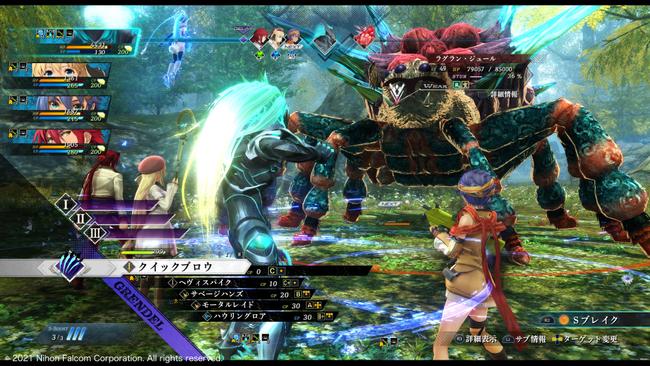
That was always inevitable, of course – Hajimari was building on the 4 games prior to it, while Kuro is the first in its own unique style. As far as things go, it’s a solid foundation. Instead of combat links, each character now has a ring around them that, if it comes into contact with another party member’s, they’ll be able to either follow-up on their attacks or support their actions in other ways, similar to the effects of links in previous games. Some characters use guns, like Feri, and you can’t shoot through your party members. So, in addition to making sure that they’re connected to another party member for a follow-up, you’ve got to consider your positioning to make sure that everything is efficient.
Shard Boosts make this easier – much like the Valiant Rage system from Hajimari, players have access to boost charges that will raise as you destroy boxes, vases, and what-have-you in the overworld, as well as by attacking enemies in general. Using Shard Boosts will raise some of your stats, depending on what Hollow Core you have equipped, and will buff the chances for certain abilities that you’ve slotted on your orbment from activating. Using 2 Shard Boosts on a character will increase the range of their ring, allowing them to link with party members more easily – it’ll also allow them to use their S-Craft, if they have enough CP.
Unlike previous games in the series, it’s no longer enough to simply have more than 100 CP in order to use an S-Craft – characters will also have to either be under the influence of 2 Shard Boosts, or you must have enough Boost Gauge in order to activate those boosts at the same time you want to use a character’s S-Craft. Additionally, S-Crafts are locked at only using 100 CP this time around, and there’s no such thing as the concept of an over-charge.. All in all, it’s a juggle of resources and positioning – I’d liken it to something like Lost Dimension’s battle system, but nobody played that game so I’m not sure if it’s the best comparison. Either way, it’s a lot of fun, and fundamentally different from the games that came before it.
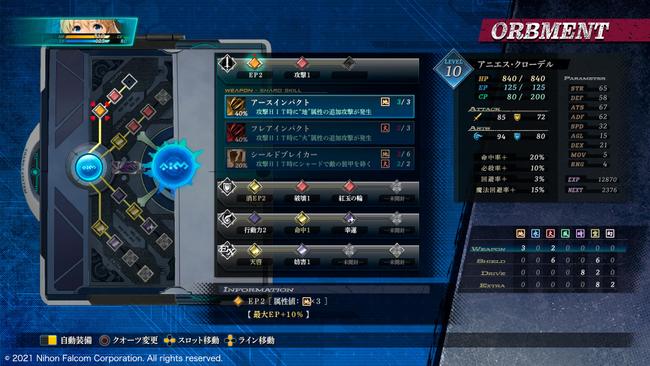
I mentioned it earlier, but Orbments have been changed yet again – Calvard’s system brings things back a little closer to the systems of the past, where each Quartz had an elemental affinity, and stacking enough of a certain element, or a mix of several elements, on a line would unlock additional effects. Instead of Arts this time around, however, you’re given different buffs with a percentage chance to apply, that can then have their rate of activating increased by Shard Boost. Each line is now directly tied to a specific attribute – physical attacks, defense, arts, and an “Extra” line. Arts are now completely determined by a separate “Arts Driver”, which you can supplement with plugins that you can either find throughout the overworld, receive as rewards, or purchases from shops. Put simply – Hollow Cores, which offer base stats that will increase as you level them up, and Arts Drivers, are essentially Master Quartz split into two categories this go around.
It’s a lot to go off of, but at the same time – unless you’re actively targeting harder difficulties, you can probably pay little attention to these. It strikes a good enough balance of allowing players to make their own unique builds, while also not acting as an obstacle for players that are mostly in it for the story.
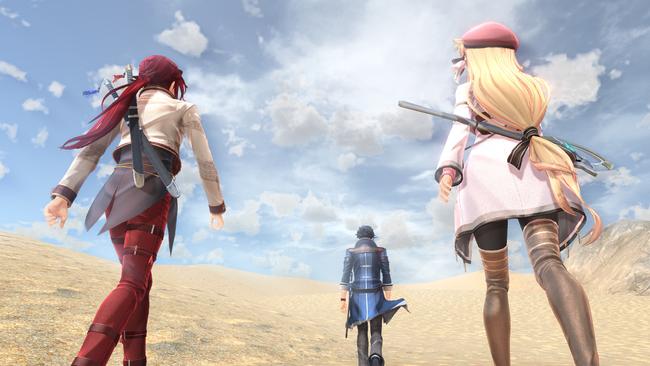
As for everything else about the game – most of Kuro’s soundtrack is great, albeit there are tons of stinkers too. The new engine is nice, and there are certainly some moments where the new lighting engine shines; I would’ve been much more conflicted about the shift, but Falcom released a patch the very day after I finished the game fixing most of my issues. While the game I played was capped at 30FPS with long load times, even on a PlayStation 5, that’s not what players will experience when it gets localized. The game now loads much faster, many cutscenes have been improved, and the game now runs at a solid 60FPS; not to mention quality of life features like being able to skip S-Craft and Arts animations. It appears that the game is running much better on PS4 after the patch too, but something tells me most players will be on PS5 by the time the game gets localized anyways, so it’s kind of a moot point.
Kuro no Kiseki is far from a perfect game; at the end of the day, despite all of its improvements, its budget and Falcom’s own limitations shine through. Yet at the best of times, that never really mattered. For series fans, Kuro is a confident step forward into the series' future. I just wish that fans the world over could have access to this game sooner – regardless, I’m more than ready to see exactly what Falcom has in store for Trails next.